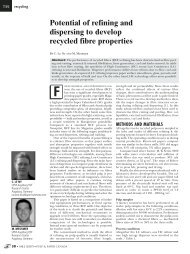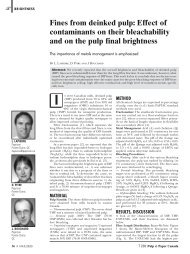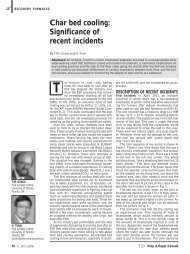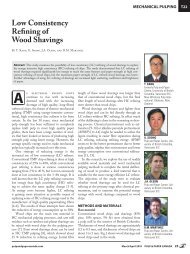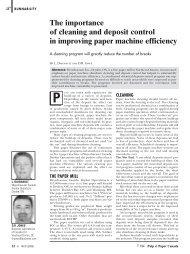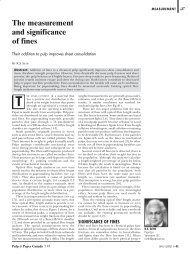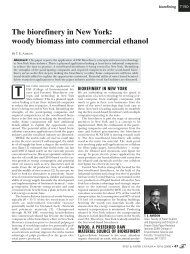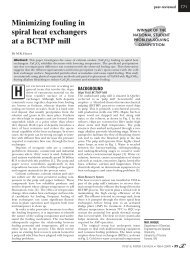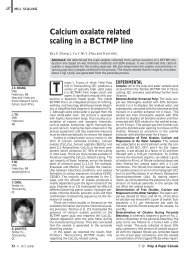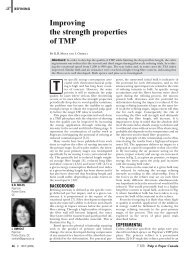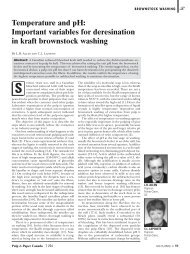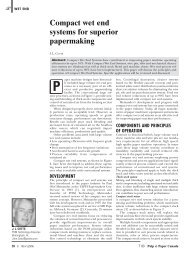T33<strong>oxygen</strong> <strong>delignification</strong>FIG. 5. Slope (1/min) vs. predicted reaction rate constant k.FIG. 6. Oxygen <strong>delignification</strong> rate <strong>of</strong> Loblolly pine kraftpulps at different kappa no. levels.FIG. 7. Phenolic group content <strong>of</strong> liquor <strong>and</strong> pulp at differentreaction times.liquor was also measured. Figure 7 showsthese values <strong>and</strong> that <strong>of</strong> the pulps at differentreaction times as well as the sum<strong>of</strong> the phenolic group content in the pulp<strong>and</strong> liquor based on original pulp. As canbe seen, the reduction in the amount <strong>of</strong>phenolic groups in the pulp is nearly equalto the amount <strong>of</strong> phenolic groups removedwith the liquor since the sum <strong>of</strong> phenolicgroups does not change significantly during<strong>oxygen</strong> <strong>delignification</strong>. This suggeststhat the dissolved lignin is still mostlyaromatic in nature.Finally, we found that the ratio(MeOH formation rate/32) / (<strong>delignification</strong>rate/185), as determined from themethanol <strong>and</strong> lignin content <strong>of</strong> the liquorsamples, remains mostly constant during<strong>delignification</strong> at about 0.9 ± 0.2. Thismeans that methanol is released essentiallyquantitatively from lignin monomer unitswhen they are solubilized 11The <strong>delignification</strong> rate versus residuallignin <strong>of</strong> three brown stock pulps cookedto different kappa numbers from the sameLoblolly Pine (Figure 6) shows an initialfast rate. However, after <strong>oxygen</strong> delignifiashas been discussed by van Heiningenet al 17 .The first order behavior in L Ccan beinterpreted that the lignin active sites, L *– ,are uniformly distributed throughout thelignin, <strong>and</strong> have the same reactivity duringthe entire <strong>oxygen</strong> <strong>delignification</strong> process.It is generally accepted that the first <strong>step</strong>during <strong>oxygen</strong> <strong>delignification</strong> is the dissociation<strong>of</strong> the phenolic groups. This isthe reason why the phenolic group content<strong>of</strong> residual lignin was measured before <strong>and</strong>after <strong>oxygen</strong> <strong>delignification</strong>. In agreementwith literature data 7 we obtained values forthe phenolic fraction <strong>of</strong> lignin in the originalpulp <strong>of</strong> around 0.41 <strong>and</strong> after 60 min at90°C, 0.52 MPa <strong>oxygen</strong> pressure <strong>and</strong> 3.3g/l <strong>of</strong> NaOH <strong>of</strong> around 0.27. After 3 h <strong>of</strong><strong>oxygen</strong> <strong>delignification</strong>, the phenolic fraction<strong>of</strong> the residual lignin in pulp decreasesfurther to 0.22, i.e. to half the initial value.Based on this <strong>and</strong> on the high pKa value <strong>of</strong>the lignin active sites, L *– we suggests thatthe rate <strong>determining</strong> <strong>step</strong> <strong>of</strong> <strong>oxygen</strong> <strong>delignification</strong>is not a direct attack <strong>of</strong> <strong>oxygen</strong>on the dissociated phenolic groups.The phenolic lignin content <strong>of</strong> theFIG. 8. Three experiments; (1) experiment in Berty CSTRduring 3 h; (2) 60 min batch reactor + 80 min Berty CSTR;(3) 20 min batch reactor + 75 min Berty CSTR.cation <strong>of</strong> the fresh 24.4 kappa brownstockpulp for different times (20 <strong>and</strong> 60 minutes)in a batch reactor, continued <strong>delignification</strong>in the CSTR does not displaythe initial fast rate (Figure 8). The absence<strong>of</strong> the initial fast rate for the latter twopulps has been explained by the absence<strong>of</strong> hemicelluloses with reducing ends <strong>and</strong>attached lignin fragments in these pulps 17 .Figure 8 also shows that the <strong>oxygen</strong> delignifiedpulp obtained in a batch reactor hasa similar <strong>delignification</strong> rate as the originalpulp. This implies that lignin condensationis insignificant in a batch reactor since thepulps are exposed to high concentrations <strong>of</strong>dissolved lignin at the end <strong>of</strong> the <strong>delignification</strong>process.Delignification mechanismBased on the presented data we proposethat the active lignin site is not the phenolicgroup, but another less acidic sitewhich is uniformly distributed throughoutthe residual lignin to satisfy the first orderin lignin rate behavior. Because hydroperoxideshave a pKa <strong>of</strong> 12 – 13 comparedto about 10.5 for Indulin AT at room32 March 2009 Pulp & Paper Canada pulp<strong>and</strong>papercanada.com
peer reviewedT34a)R 1OH -R 1R 1R 2 OCH 3OHpKa 10-11R 2 OCH 3 R 2OO 2OOCH3R 1O 2-R 1O-OR 1O-OHR 2 OCH 3b)OR 2 OCH 3OpKa 12-13R 1R 2 OCH 3OR 1CO 2CO 2+ CH 3 OHR 2 OCH 3OO-OR 2R 1R 2temperature 13 , a mechanism proposed by Chang <strong>and</strong> Gratzl 18was adopted to explain the present <strong>kinetics</strong>. Figure 9 shows theformation <strong>of</strong> cyclohexadienone hydroperoxide by attack <strong>of</strong> <strong>oxygen</strong>at alkaline conditions on phenolic lignin.As illustrated, a hydroperoxide anion is formed by reaction<strong>of</strong> superoxide radical anion with the phenolate radical located atthe carbon 3 position. Chemical computational modeling 19 tocalculate the enthalpies <strong>of</strong> reactions <strong>of</strong> lignin model shows thatthe reaction pathway in Figure 19 9a is possible. Other phenolateradical intermediates have been proposed (McDonough 1996)where the radical is located on carbon 1 <strong>and</strong> the beta carbon inaddition to the carbon 3 shown in Figure a. All these three structuresare part <strong>of</strong> the same resonance structure in which the oddelectron formally resides at each <strong>of</strong> the three carbon positions.The explanation, why the coupling <strong>of</strong> the superoxide anion radicalwith the radical at the carbon 1 <strong>and</strong> beta carbon is not effectivefor <strong>delignification</strong>, is likely that the formation <strong>of</strong> the respectiveoxirane <strong>and</strong> carbonyl structures is much more difficult than theformation <strong>of</strong> the muconic acid <strong>and</strong> quinone structures shown inFigure 9b when the hydroperoxide anion is located at the carbon3 position.Figure 9b shows that the hydroperoxide anion forms either amuconic acid structure <strong>and</strong> MeOH or an orthoquinone structure<strong>and</strong> MeOH. Since the hydroperoxide anion is the dominant speciesat pH > 12~13, based on the present <strong>kinetics</strong> is probable thatthe carbon at the 3 position <strong>of</strong> the lignin aromatic ring is the activesite for <strong>oxygen</strong> <strong>delignification</strong>. Thus the present <strong>kinetics</strong> may beinterpreted that the rate <strong>determining</strong> <strong>step</strong> is the unimoleculardecomposition <strong>of</strong> the formed hydroperoxide anion, i.e. the rateis determined by the dissociated hydroperoxide concentration.The latter is determined by the concentration <strong>of</strong> adsorbed <strong>oxygen</strong>on methoxyl groups at the carbon 3 (the lignin active site, L*),as well as by the pKa <strong>of</strong> the hydroperoxide. Further support thatthe carbon 3 with a methoxyl group is the lignin active site, L*,O+ CH 3 OHOFigure 9 Reaction FIG. 9. mechanism Reaction <strong>of</strong> lignin mechanism with <strong>oxygen</strong> <strong>of</strong> (adopted lignin with from Chang <strong>oxygen</strong> <strong>and</strong> (adopted Gratzl, 1980 18 ). a)Formation <strong>of</strong> cyclohexadienon hydroperoxides by attack <strong>of</strong> <strong>oxygen</strong>. b) Homolytic <strong>and</strong> heterolyticfrom Chang <strong>and</strong> Gratzl, 1980 18). a) Formation <strong>of</strong> cyclo-fragmentation <strong>of</strong> para-cyclohexadienone hydroperoxidaseshexadienon hydroperoxides by attack <strong>of</strong> <strong>oxygen</strong>. b) Homolytic<strong>and</strong> heterolytic fragmentation <strong>of</strong> para-cyclohexadienonehydroperoxidases.FIG. 10. Cellulose degradation in CSTR <strong>and</strong> batch reactors;Experimental <strong>and</strong> predicted data.is that almost all residual s<strong>of</strong>twood lignin monomer units containthis moiety, thus explaining the uniform reactivity <strong>and</strong> first order<strong>kinetics</strong> in residual lignin for <strong>oxygen</strong> <strong>delignification</strong>.The pH dependence <strong>of</strong> the <strong>kinetics</strong> implies that the protonatedhydroperoxide does not fragment into muconic acid orquinone structures. Also, the fact that dissolved lignin mostlyretains its aromatic nature, <strong>and</strong> that MeOH is released essentiallyquantitatively during <strong>delignification</strong>, further support the hypothesisthat quinone formation is the dominant pathway.Kinetics <strong>of</strong> cellulose degradationThe cleavage <strong>of</strong> cellulose was modeled by Iribarne <strong>and</strong> Schroeder19 as the increase in number-average moles <strong>of</strong> cellulose per gram<strong>of</strong> pulp (m n). Similarly one can describe the cellulose degradationby the number <strong>of</strong> cellulose chain scissions during <strong>oxygen</strong> <strong>delignification</strong>.Violette <strong>and</strong> van Heiningen 20 calculate the number <strong>of</strong>cellulose chain scissions from the average degree <strong>of</strong> depolymerization<strong>of</strong> cellulose (DP) in the pulp at time t=0 <strong>and</strong> time t=t, as 1/DP t-1/DP 0. DP can be obtained from the intrinsic viscosity [h]by equation (15). This formula considers the actual weight <strong>of</strong>cellulose rather than the pulp weight being responsible for theviscosity, <strong>and</strong> makes a correction for the small contribution <strong>of</strong> thehemicelluloses to the pulp intrinsic viscosity 21 .1.65[h] – 116H1.111DP <strong>of</strong> Celluose = ( ——————— ) (15)Gwhere [h] is intrinsic viscosity <strong>of</strong> the pulp in cm 3 /g, <strong>and</strong> G <strong>and</strong> Hare the mass fractions <strong>of</strong> cellulose <strong>and</strong> hemicellulose in the pulp(see Table 2). This formula considers the actual weight <strong>of</strong> celluloserather than the pulp weight being responsible for the pulpviscosity, <strong>and</strong> makes a correction for the small contribution <strong>of</strong> thehemicelluloses to the intrinsic viscosity.The number <strong>of</strong> moles <strong>of</strong> cellulose per gram <strong>of</strong> pulp, mn, canbe calculated by equation (16) as 22 :1 1 Moles162DP n+18 _ 162DP nGram Pulpm n= ––––––––– . ––––––– (–––––––––– )(16)The content <strong>of</strong> cellulose (G) <strong>and</strong> hemicellulose (H) in the pulpwas measured by high pressure anion exchange chromatography(HPAEC) on double hydrolyzed pulp samples 23 . The results forthe pulp samples are listed in Table 2.pulp<strong>and</strong>papercanada.com Pulp & Paper Canada March 2009 33



